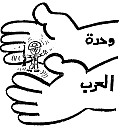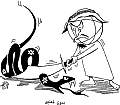|
Images
Click on any image to see a large version.
 |
Arab Unity - Sabah al-Khair, June 12, 1986
Israel, by its very existence, is a threat to the goal of the Arab
nation - unity.
|

|
Wartime: Arab Unity - Ruz al-Yusuf, Egypt, June 5, 1967
The Zionist midget is about to be destroyed in the powerful arms of Egypt and
Syria. The destruction of Israel is a condition for Arab unity, but the dispute
still has regional character. This caricature was published the day the Six Day
War broke out, which may lend the caricature a kind of situational legitimacy,
since it serves the war effort.
|

|
Peacetime:Arab Unity - Al-Sha'ab, Egypt, May 30, 1989
The caricature accompanies an article calling for war against Israel,
the Zionist entity, as a precondition for Arab unity. In contrast to
the message conveyed in the caricature of 1967 entitled "Wartime" the message
here is of a worldwide conflict. Here, the target is not just Israel,
but all Jews. The Jewish fangs are aimed at all humanity, and the
Arabs, under Egyptian leadership (note the globe wearing a kaffiyeh)
have the task of eliminating the scourge. This is 11 years after Camp
David.
|
|

|
Die Judenspeiss - wood engraving, Strassburg, 1541.
This picture is from an anti-Semitic leaflet aimed at arousing contempt
for Jewish moneylenders. THe artist was fully aware of the purpose of
his engraving, which nevertheless does not contain any distorted
physical reflection of the Jew or his family. In fact, the mother shown
rocking her child in the cradle imparts human warmth and softness to the
libelous character of the basic message. Since the Jews are shown at
home, there is no need for special identifying marks, such as the Jewish
badge which the artist has in fact foregone. One sees an objective
depiction of a typical room in a home, rendered in faithful detail,
without malice. Yet what the engraving lacks is made up for in the
accompanying caption, which reproaches the Jew for his devious ways.
Such integration of objective illustration and venomous accompanying
text is a common genre of anti-Semitic art in the later Middle Ages.
|
|

|
Uradel by Aubrey Beardsley
With the discovery of the statue Venus de Milo (1920) and its exhibition
at the Louvre, this Hellenistic masterpiece came to be considered the
incarnation of feminine beauty, while admiration for classical Graeco-Roman
beauty in Europe reached unprecedented heights. The proportions between the
statue’s head, torso and limbs were measured precisely and invoked as the
final word in human physical perfection.
An example of the Jew being held up as the antithesis of such perfection is
Aubrey Beardsley’s Uradel. The black mass with short legs, fat hands, head
directly connected to the torso, the crooked, bulbous nose, intended to
accentuate the ugliness of the profile, are all a caricature of the ideal of
perfection. Beardsley, who took the mannerism of late nineteenth century
European decadence to absurd limits, painted the antithesis to his own style in
Uradel.
|
|

